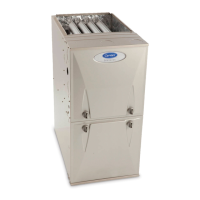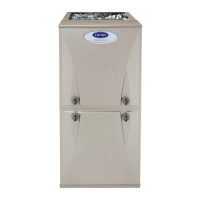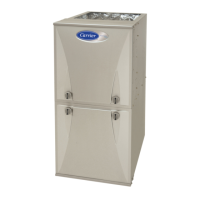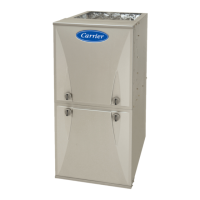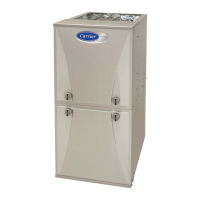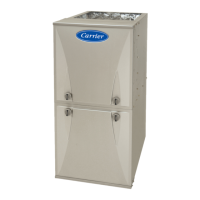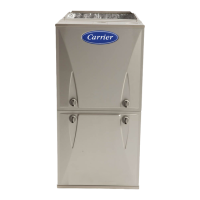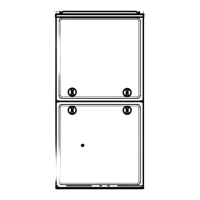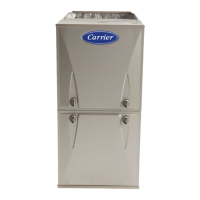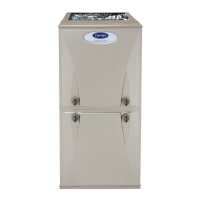c.Whencorrectinputisobtained,replacecapsthatconceal
gasvalveregulatoradjustmentscrews.Mainburnerflame
shouldbeclearblue,almosttransparent(SeeFig.57.)
d.RemovejumpersRtoW/WIandRtoW2.
3.Verifynaturalgasinputratebyclockingmeter.
a.Turnoffallothergasappliancesandpilotsservedbythe
meter.
b.MovesetupswitchSWI-2toONposition.Thiskeepsfur-
nacelockedinlow-heatoperation.
c.JumperRtoW/WI.
d.Runfurnacefor3minutesinlow-heatoperation.
e.Measuretime(insec)forgasmetertocomplete1revolu-
tionandnotereading.The2or5cubicfeetdialprovides
amoreaccuratemeasurementofgasflow.
f. RefertoTable18forcubicft.ofgasperhr.
g. Multiplygasratecuft./hrbyheatingvalue(Btuh/cuft.)
toobtaininput.Ifclockedratedoesnotmatchrequiredin-
putfromStep1,increasemanifoldpressuretoincreasein-
putordecreasemanifoldpressuretodecreaseinput.Repeat
stepsbthrougheuntilcorrectlow-heatinputisachieved.
Re-installlowheatregulatorsealcapongasvalve.
h.MovesetupswitchSWI-2toOFFpositionandjumperR
toW/WI,andW2.Repeatitemsdthroughgforhigh-heat
operation.
Adjust Temperature Rise
NOTE: Blower door must be installed when taking temperature
rise reading. Leaving blower door off will result in incorrect
temperature measurements.
FURNACE DAMAGE HAZARD
Failure to follow this caution may result in:
• Overheating the heat exchangers or condensing flue gases
in heat exchanger areas not designed for condensate,
• Shortened furnace life
• Component damage.
Temperature rise must be within limits specified on furnace
rating plate. Recommended operation is at midpoint of rise
range or slightly above.
When setup switch SW1-4 is ON, operation will be near the high
end of the rise range for improved comfort.
Furnace must operate within ranges of temperature rise specified
on the furnace rating plate. Determine air temperature rise as
follows:
a. Place thermometers in return and supply ducts as near fur-
nace as possible. Be sure thermometers do not see heat ex-
changer so that radiant heat does not affect readings. This
practice is particularly important with straight-run ducts.
b. When thermometer readings stabilize, subtract return-air
temperature from supply-air temperature to determine air
temperature rise.
NOTE: Temperature rise can be determined for low-heat
operation by placing setup switch SWI-2 on furnace control in
ON position. For high-heat operation, place setup switch SWI-2
in OFF position and jumper R-W2 on furnace control. DO NOT
forget to return setup switch to OFF position and remove R-W2
jumper upon completion of testing.
c. This furnace is capable of automatically providing proper
airflow to maintain the temperature rise within the range
d.
e.
f.
g.
h.
i.
specified on furnace rating plate. If temperature rise is out-
side this range, proceed as follows:
(1.) Check gas input for low- and high-heat operation.
(2.) Check derate for altitude if applicable.
(3.) Check all return and supply ducts for excessive
restrictions causing static pressure greater than
0.5-In. W.C.
(40 Ensure Low Heat Rise Adjust switch SWl-3 on
furnace control is in ON position when a bypass
humidifier is used. (See Fig. 35 for switch loca-
tion.)
(5.) Make sure proper model plug is installed.
Remove thermostat jumpers and release blower door
switch.
Repeat Steps a through c as required to adjust for high heat
temperature rise.
When correct high heat input rate and temperature rise is
achieved, turn gas valve ON/OFF switch to OFF.
Release blower door switch.
Remove manometer or similar device from gas valve.
Re-install manifold pressure tap plug in gas valve. (See
Fig. 510
FIRE HAZARD
Failure to follow this warning could result in personal
iniury, death, and/or property damage.
Reinstall manifold pressure tap plug in gas valve to prevent
gas leak.
j. Remove thermostat jumper wire from furnace control
board.
k. Turn gas valve ON/OFF switch to ON.
1. Proceed to "Set Blower Off Delay" before installing
blower door.
Adjust Blower Off Delay (Heat Mode)
a. Remove blower door if installed.
b. Turn Dip switch SW-7 or SW-8 ON or OFF for desired
blower off delay. (See Table 17 and Fig. 35, Fig. 55 and
Fig. 64.)
Adjust Cooling Airflow - High-Speed and
Low-Speed Cooling
The ECM blower can be adjusted for a range of airflows for
low-speed or high-speed cooling. See Table 7 - Air Delivery -
CFM (With Filter ) and Fig. 55 - Furnace Setup Switches and
Descriptions. Depending on the model size, the cooling airflow
can be adjusted from 1.5 to 6 tons based on 350 CFM ton.
NOTE: 6 ton airflow will truncate at 2200 CFM on applicable
models.
The high-speed or single-speed cooling airflow is adjusted by
turning Setup switches SW2-1, SW2-2 and SW2-3 either ON or
OFF. Select the required airflow from Table 7. Table 7 is based
upon 350 CFM per ton. For other CFM per ton Setup switch
selections, see Fig. 35, Fig. 55 and Fig. 64.
The Continuous Fan airflow selection via Setup switches SW3 is
also the airflow for low-speed cooling when the furnace is used
with a 2-speed cooling or heat pump unit. Adjust the Continuous
Fan CFM Setup switches SW3 to match the airflow required for
low-speed cooling. Select the required airflow from Table 7 and
Fig. 55.
ii
63
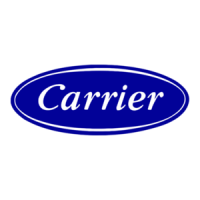
